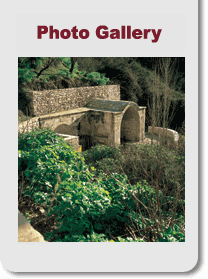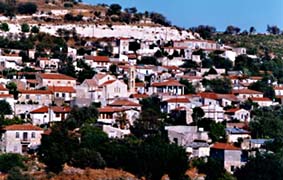 The
village of Arsos is one of the biggest wine producing
villages in Cyprus. It lies 40 kilometres from Limassol
and 45 kilometres from Paphos It is built on the slopes
of Laona mountain, 1092 metres above sea level, with an
open horizon on the Valley of the Diarizos River, as far
as the sea of Paphos. Thanks to this geographical position,
it enjoys a wonderful cool and dry climate in summer and
attracts therefore hundreds of holidaymakers. The
village of Arsos is one of the biggest wine producing
villages in Cyprus. It lies 40 kilometres from Limassol
and 45 kilometres from Paphos It is built on the slopes
of Laona mountain, 1092 metres above sea level, with an
open horizon on the Valley of the Diarizos River, as far
as the sea of Paphos. Thanks to this geographical position,
it enjoys a wonderful cool and dry climate in summer and
attracts therefore hundreds of holidaymakers.
There are two versions about its name.
One says that it comes from the Holy Alsos (grove) of
the goddess Aphrodite, where the village is built, and
the other tells us that it was one of the 4 towns founded
by Ptolemy Philadelphos in the honour of Arsinoe.
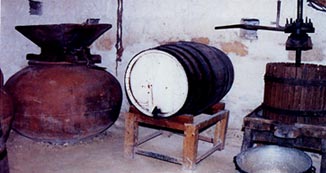 Since
the most ancient times, it has developed into a big
rich wine-producing village. All the inhabitants of
the village make their own wine, especially red wine,
and keep it in big earthenware jars. They grow mainly
dark grapes, xynisteri, as well as new varieties suitable
for the production of wine. The jars and the winepress
for the production of the famous Arsos wine, as well
as the alembics for the production of zivania can be
found in most houses. Since
the most ancient times, it has developed into a big
rich wine-producing village. All the inhabitants of
the village make their own wine, especially red wine,
and keep it in big earthenware jars. They grow mainly
dark grapes, xynisteri, as well as new varieties suitable
for the production of wine. The jars and the winepress
for the production of the famous Arsos wine, as well
as the alembics for the production of zivania can be
found in most houses.
From spring to autumn, the emerald colour
of the vineyards dominates all around the village.
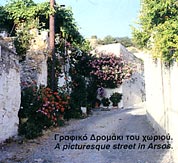 The
houses in the village are close to each other. It is
a classical example of a densely constructed settlement.
The narrow streets, the lengthy houses (makrynaria),
the spacious two-roomed houses (dichora) and the two-storied
houses (anoyia), all built with impeccably hewn stones
give, in combination with the tiled roofs, give a special
charm to the architecture of the village. The numerous
neo-classical buildings are also characteristic. The
houses in the village are close to each other. It is
a classical example of a densely constructed settlement.
The narrow streets, the lengthy houses (makrynaria),
the spacious two-roomed houses (dichora) and the two-storied
houses (anoyia), all built with impeccably hewn stones
give, in combination with the tiled roofs, give a special
charm to the architecture of the village. The numerous
neo-classical buildings are also characteristic.
The hospitality of the inhabitants of
the village, the cleanness of the houses and the streets,
the wonderful picturesque yards and all the varieties
of flowers and greenery are characteristic.
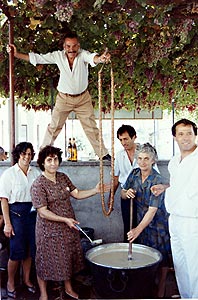 The housewives of the village are famous for their dexterity
in preparing the different dishes such as ''palouzes",
''epsima'', ''biscuits with episma'', ''paste'', ''shoudzioukos'',
''kiofterka'', ''arkatena'', ''kattimerka'', '' glyko
'' and many others. The housewives of the village are famous for their dexterity
in preparing the different dishes such as ''palouzes",
''epsima'', ''biscuits with episma'', ''paste'', ''shoudzioukos'',
''kiofterka'', ''arkatena'', ''kattimerka'', '' glyko
'' and many others.
The village experienced an important
development from 1920 to 1960. The population of the
village amounted to 2.000 inhabitants. The unprofitable
viticulture, the bad road network in those days and
the search for a better fortune in the cities led the
village to decay and abandonment. Nowadays, only around
300 people have remained in the village; they keep and
transmit a tradition rich in manners and customs.
The Arsos Development Association, which
was founded 17 years ago, aims at the maintenance of
the manners and customs of the village, and the preservation
of its architectural character together with modern
development, in order to transform it into a viable
place for the young. The main activities of the Association
are tree-planting every January, Eastern festivities,
the Cyprus night in June, the August festival, the palouze
feast etc.
Apostolos Philippos Church.
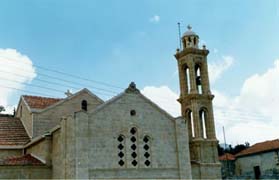 The
church of the village is dedicated to Apostle Philip,
the patron saint of the Community. The magnificent Byzantine
church stands in the middle of the village; it dates
back to the 12th century and is unique in its kind and
dimensions. It has been declared an ancient monument
by the Department of Antiquities and has recently been
restored. Inside the church, you can see its ancient
woodcut iconostasis dating from the 18th century with
the old icons. The big icon of Apostle Philip, as well
as a part of the Apostle's relics (13th century) are
unique. The
church of the village is dedicated to Apostle Philip,
the patron saint of the Community. The magnificent Byzantine
church stands in the middle of the village; it dates
back to the 12th century and is unique in its kind and
dimensions. It has been declared an ancient monument
by the Department of Antiquities and has recently been
restored. Inside the church, you can see its ancient
woodcut iconostasis dating from the 18th century with
the old icons. The big icon of Apostle Philip, as well
as a part of the Apostle's relics (13th century) are
unique.
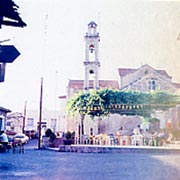 The
chapel of Ayia Mariamni, Apostle Philip's sister, which
is used as a guardroom for icons, is embodied in the
main church. Old icons dating form the 15th century
to the second half of the 19th century are kept there.
It also contains sacerdotal vestments of the priest
and the deacon from last century, votive offerings to
Apostle Philip, a crown from the 15th century, which
used to be placed on Apostle Philip's head, metalwork
items, holy evangels, holy vessels, sacerdotal vestments,
an icon of the Christ embroidered with gold, a bell
made in Venice in 1858 and a cherubim from the 19th
century The
chapel of Ayia Mariamni, Apostle Philip's sister, which
is used as a guardroom for icons, is embodied in the
main church. Old icons dating form the 15th century
to the second half of the 19th century are kept there.
It also contains sacerdotal vestments of the priest
and the deacon from last century, votive offerings to
Apostle Philip, a crown from the 15th century, which
used to be placed on Apostle Philip's head, metalwork
items, holy evangels, holy vessels, sacerdotal vestments,
an icon of the Christ embroidered with gold, a bell
made in Venice in 1858 and a cherubim from the 19th
century
In the village, there is also a second small medieval
church, dedicated to Panayia Chryseleousa of the Catholics.
In the ancient times it was a Latin Monastery.
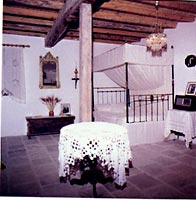 The
Folk Art Museum of the village, one of the best in its
kind, is remarkable. It is a building from the 19th
century and an ancient monument, which houses tools,
furniture, utensils from older times related to viticulture
and the other occupations of the inhabitants. The
Folk Art Museum of the village, one of the best in its
kind, is remarkable. It is a building from the 19th
century and an ancient monument, which houses tools,
furniture, utensils from older times related to viticulture
and the other occupations of the inhabitants. 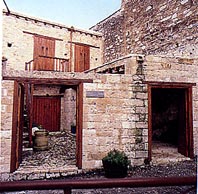 The
''Six Fountains'' nature trail along the river joins
the six medieval fountains of the village. There is
a rich fauna and flora. The fountains are linked to
the village by cobbled pathways. The
''Six Fountains'' nature trail along the river joins
the six medieval fountains of the village. There is
a rich fauna and flora. The fountains are linked to
the village by cobbled pathways.
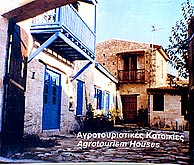 Rural tourism accommodations function in the village.
They are old houses which have been renovated and welcome
local and foreign visitors. Rural tourism accommodations function in the village.
They are old houses which have been renovated and welcome
local and foreign visitors.
|

